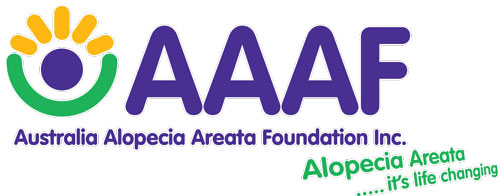The word “alopecia” means hair loss. Alopecia Areata is an auto-immune disease that results in hair loss on the scalp and elsewhere on the body. It can range from small, individual smooth patches of hair loss, to total loss of all hair on the body – including ear and nose hair. Alopecia Areata is not uncommon, and current estimates suggest that 2% of the population will be affected by the condition at some point in their lifetime. It can effect people all ages, genders and ethnicity, but most commonly presents during childhood.
There is currently no cure, however AAAF is on a mission to do all we can to work towards a cure
There are three main types of Alopecia Areata. Alopecia Areata, which means one or more patches of hair loss on the scalp. Alopecia Areata Totalis refers to total loss of hair on the head. Alopecia Areata Universalis means complete hair loss of the entire body.
In all forms of alopecia areata, the hair follicles remain alive and are ready to resume normal hair production whenever they receive the appropriate signal. In all cases, hair regrowth may occur even without treatment and even after many years. It is not currently known exactly what causes Alopecia Areata. It is believed to be a complex combination of genetic and environmental factors.
Alopecia Areata… It’s life changing.
Types Of Alopecia Areata (autoimmune hair loss)
Alopecia Areata can be a lifelong condition, and can deeply affect self-image, self-esteem, confidence and even mental health. But there is hope. AAAF believe that through personal support, improved awareness, and ongoing research toward an acceptable treatment, we can help improve the lives of people living with Alopecia Areata and their families. You can help too. By registering, donating or volunteering with AAAF you can help achieve our mission.
Understanding what category of Alopecia Areata you may have can be very confusing. Many people shorten the classification due to the difficulties in pronouncing the full names.
- ALOPECIA AREATA MONOLOCULARIS: describes baldness in only one spot. It may occur anywhere on the head.
- ALOPECIA AREATA MULTILOCULARIS: describes baldness to multiple areas of the head.
- ALOPECIA AREATA BARBAE: describes hair loss limited only to the beard.
- ALOPECIA AREATA TOTALIS: explains the total loss of all the hair on the scalp.
- ALOPECIA AREATA UNIVERSALIS: explains all body hair, including pubic hair, limb and facial hair.
- CICATRICIAL ALOPECIA: a diverse group of rare disorders that destroy the hair follicle, replace it with scar tissue, and cause permanent hair loss.
- ALOPECIA AREATA OPHIASIS: The bald area runs from ear to ear at the back of the scalp.
- PERINAEVOID ALOPECIA AREATA: is characterised by Pigmented nevi, these are spots of skin with colour different from surrounding skin – usually moles.
- TRIANGULAR ALOPECIA AREATA: a rare form of alopecia areata where the hair loss lesion presents in a triangular shape.
- RETICULAR ALOPECIA AREATA: is characterised by a net-like pattern of hair loss in which irregular areas without hair are interspersed with areas of hair on the scalp
- DIFFUSE / ANDROGENETIC ALOPECIA AREATA: has been attributed to a short anagen phase and subsequent inability of hair to grow resulting in a form of incomplete hair loss affecting the whole scalp without distinct patches
Getting Support and Finding A Cure For Alopecia Areata
Alopecia Areata can be a lifelong condition, and can deeply affect self-image, self-esteem, confidence and even mental health. But there is hope. AAAF believe that through personal support, improved awareness, and ongoing research toward an acceptable treatment, we can help improve the lives of people living with Alopecia Areata and their families. You can help too by following the steps below.
Want news and updates? To stay up to date with the latest in Alopecia Areata information, including research, our support programs, and events near you, we recommend you join our email registry. Click here.

